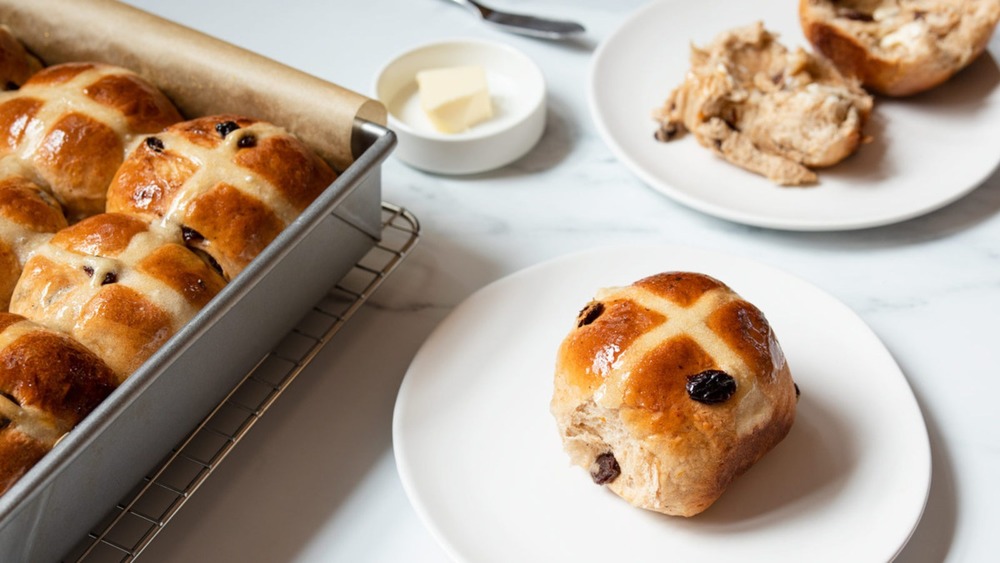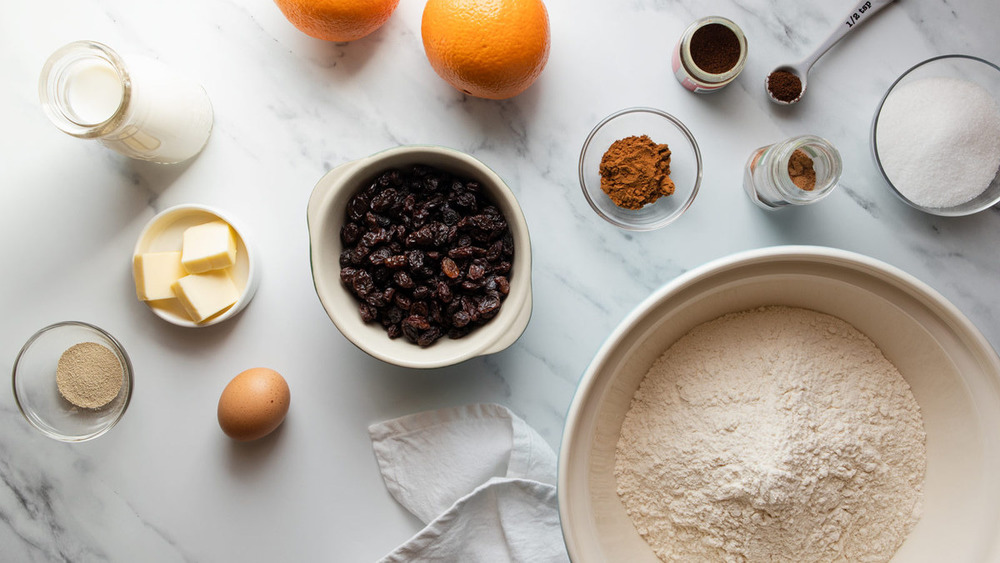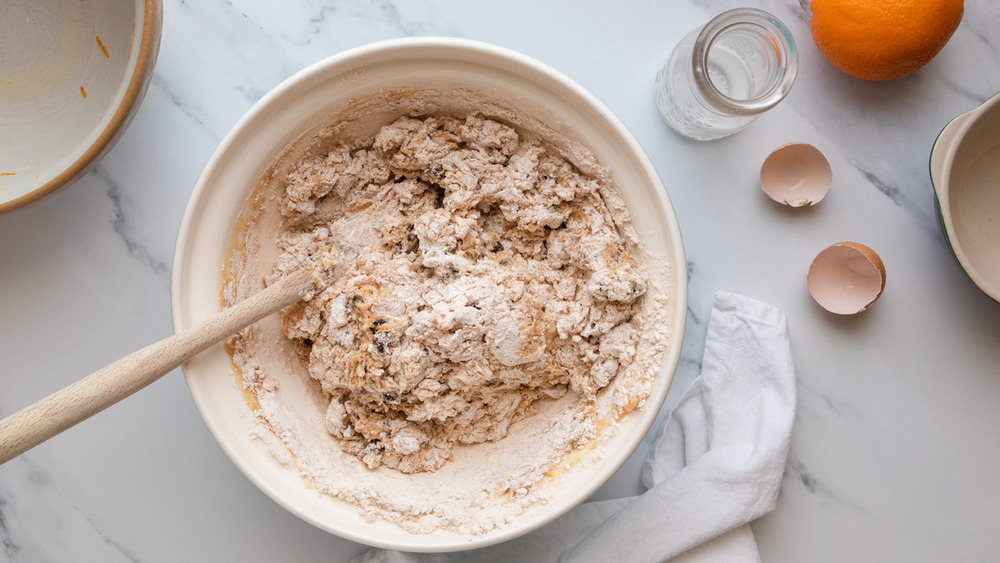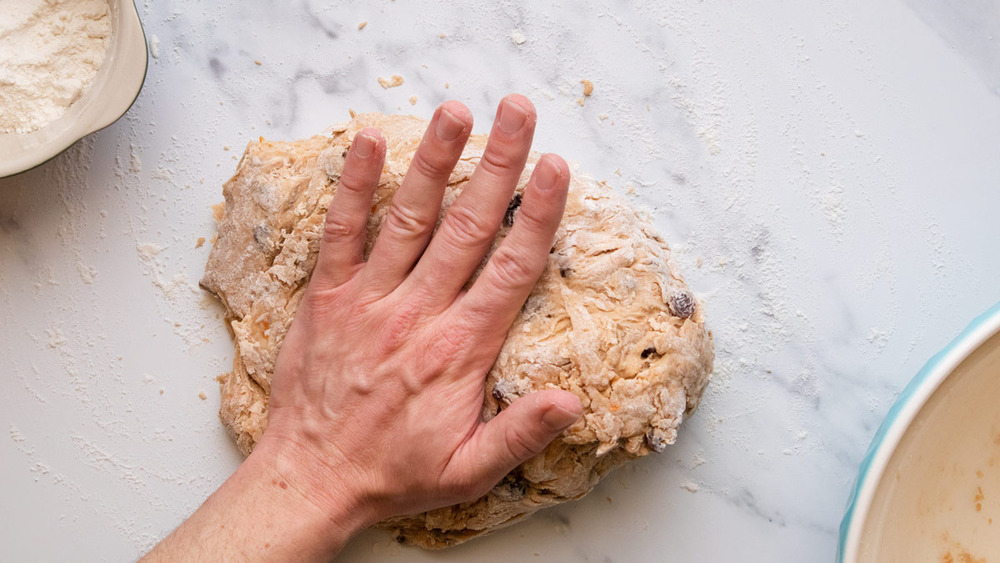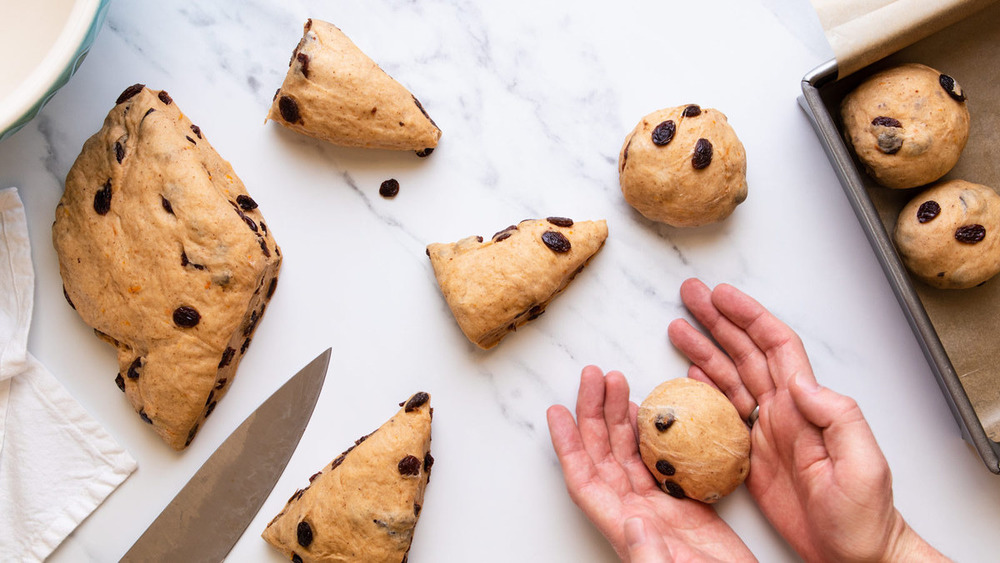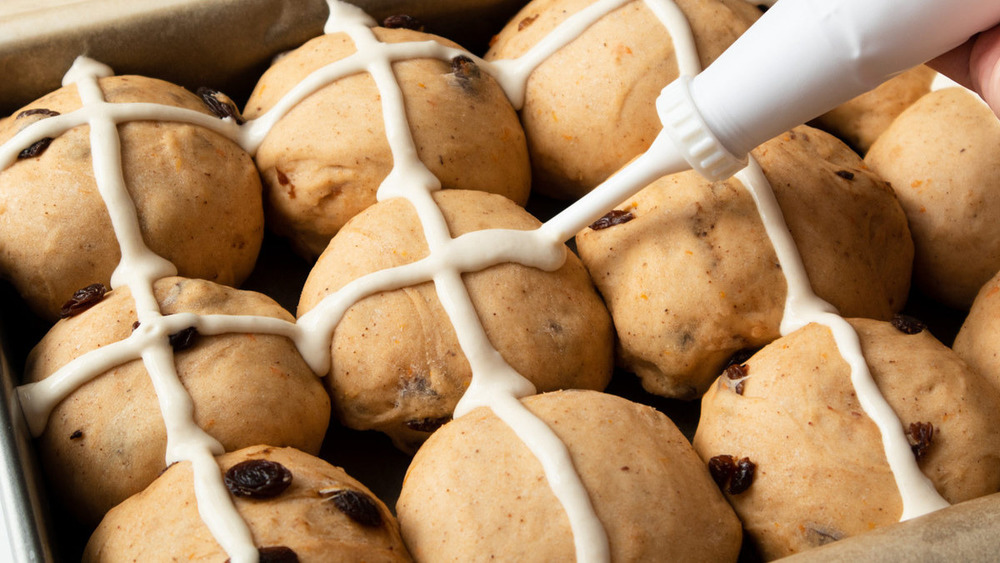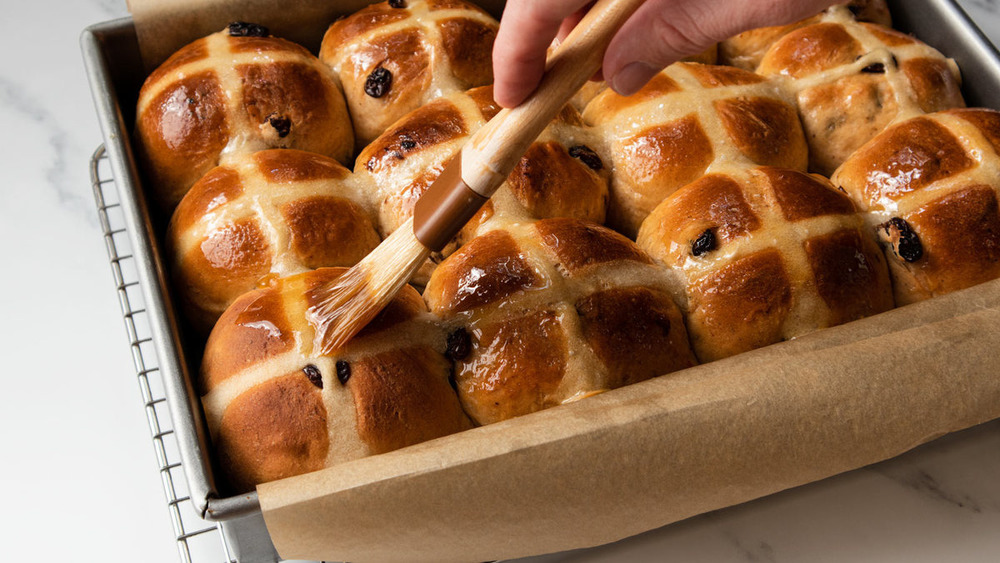Hot Cross Buns Recipe
What do you get when you pour boiling water down a rabbit hole? Hot, cross bunnies! Okay, now that we've got the obligatory dad joke out of the way, it's time to take a look at the fascinating history of this traditional Easter treat.
Smithsonian Magazine says there's a legend that hot cross buns were created by a 12th-century English monk. The first actual record of such baked goods comes from a 16th or 17th century text, although similar buns may have been eaten by the ancient Greeks. One thing is for certain, though — these buns have long been associated with Good Friday, although a law passed by Queen Elizabeth the First decreed that they could also be sold on Christmas day and on the occasion of a funeral. They were not to be sold on any ordinary day, though, since they were just too special to be eaten on some random Tuesday.
These buns from recipe developer Mark Beahm from The Sunday Baker are actually pretty economical. Not to mention, they're likely much better-tasting, not to mention fresher, than any buns you can buy from a bakery. They are a bit time-consuming to make, but then, Easter comes but once a year.
Assemble the ingredients for the hot cross buns
Before you begin baking your hot cross buns, it's best to gather all your ingredients to make sure you've got everything you need. For dry ingredients, you'll need active dry yeast (the usual kind sold in packets or jars in the baking aisle), sugar, bread flour, all-purpose flour, salt, cinnamon, nutmeg, and ground cloves. The wet ingredients include whole milk, an egg, unsalted butter, honey, orange zest, and raisins, although you can skip this last ingredient if you're a raisin-hater. If, on the other hand, you are evil and have friends who hate raisins, you can use golden raisins instead of the brown ones. Their lighter color makes them much harder to pick out.
Make the dough for hot cross buns
You're going to start by warming the milk until it's about 110 degrees — needless to say, a candy/deep fry thermometer should help with this. Whisk the yeast and one teaspoon of the sugar into the warm milk and let it stand until the whole mixture starts to get foamy, something Beahm says should take about ten minutes. At this point, you'll add in the rest of the sugar along with the egg, the melted butter, the raisins, and the orange zest.
In a separate bowl, whisk together the bread flour (or five cups of the all-purpose flour if you'll be using that instead), the spices, and the salt. Make a well in the middle of the dry ingredients and pour in the wet stuff, then stir until the dough starts coming together.
Knead the hot cross buns dough and let them rise
Once your hot cross buns dough actually looks dough-like, it's time for the (not too) hard work: the kneading. Sprinkle your work surface with a generous dusting of flour, then place the dough on the floured surface and knead away until it's smooth. Beahm says this should only take about five minutes, so your arms probably won't get too worn out. Roll the dough up into a ball, then place it in a lightly oiled bowl. Cover it with a damp cloth towel or some plastic wrap, then let it sit in a warm spot for about an hour or so until it appears to have doubled in size.
Prepare the hot cross buns for baking
While your hot cross buns dough is rising, you can lightly grease a 9x13-inch pan, line it with parchment paper, then grease the paper for good measure. After the dough is done with its first rising (there will be a second one), place it on a floured work surface again and flatten it gently to deflate it a bit. At this point, divide the dough into 12 equally-sized pieces, then shape these into smooth rounds. Pinch the bottom of each round in order to seal it, then place it in the greased pan. Once all the rolls are shaped and in place, cover the pan with plastic wrap and let them rise once more for another hour. By the end of this time, they should be all puffed-up and touching each other.
Pipe the frosting crosses onto the hot cross buns
When the hot cross buns are reaching the end of their second rise, preheat the oven to 400 degrees Fahrenheit. While it's heating, you'll be preparing the frosting. Mix the all-purpose flour together with enough water to make a thick paste, then scoop it onto a piping bag with a fine tip or else a Ziploc bag with one corner snipped off. Pipe a small line down the center of each row of buns, then another row that goes down the center of each column. This way, you get a cross on each bun without having to pipe 12 individual ones.
If a frosting made of nothing more than flour and water doesn't sound too tasty, don't worry about it. You'll be adding some sweetness once the buns are baked, but this sturdy paste will keep its shape through the baking process so you'll get those pretty white crosses.
Finish off the hot cross buns
Bake the buns for 20 to 25 minutes, or until they're golden-brown on top. Just as they're finishing up, heat the honey in a small pan over low heat. Brush the tops of the buns with the honey to make a nice glaze as soon as they come out of the oven.
The hot cross buns will keep for up to two days at room temperature if you cover them tightly with foil or plastic wrap, or they can last up to a week in the fridge. If you're the prep-in-advance type, you can freeze these buns either before or after baking. To freeze unbaked buns, shape them, but don't let them rise for a second time. Instead, space them out on a baking sheet before placing them in the freezer. Once they're frozen, you can move them to a freezer bag, and they won't get stuck together.
When you want to bake them, take them out of the bag and separate them again, then let them sit at room temperature for four to five hours so they can thaw while they rise (or vice-versa). If you prefer to freeze the buns after they've been baked, it's best to do so before you apply the honey glaze. Thaw them in the fridge when it's time to eat them, then reheat them in the oven and finish them off with the glaze.
Hot cross buns directions
These buns from recipe developer Mark Beahm from The Sunday Baker are a bit time-consuming to make, but then, Easter comes but once a year.
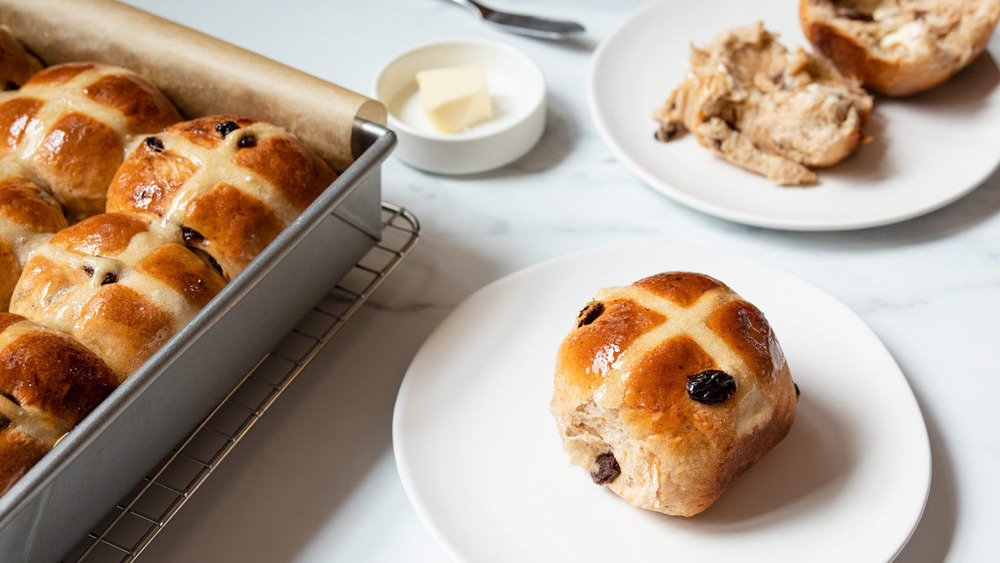
Ingredients
- 2 1/4 teaspoons (1 packet) active dry yeast
- 1 1/2 cups whole milk, warmed to about 110 degrees Fahrenheit
- 1/2 cup sugar
- 1 large egg, room temperature
- 3 tablespoons unsalted butter, melted
- 1 1/2 cups raisins
- Zest from 1 orange
- 5 cups bread flour
- 1 tablespoon cinnamon
- 1/2 teaspoon nutmeg
- 1/2 teaspoon cloves
- 1/2 teaspoon salt
- 2/3 cup all-purpose flour
- 1/2 cup water
- 2 tablespoons honey
Directions
- In a mixing bowl, whisk together the yeast and a teaspoon of the sugar into the milk and let stand until it begins to foam (about 10 minutes).
- Add the remaining sugar, egg, butter, raisins, and zest to the milk mixture and stir to combine.
- Whisk together the bread flour, cinnamon, nutmeg, cloves, and salt in a large mixing bowl.
- Make a well in the flour mixture and pour in the milk mixture, stirring until the dough comes together.
- Generously dust a work surface with flour. Tip the dough onto the counter and knead until smooth (about 5 minutes).
- Form the dough into a ball and transfer to a lightly oiled bowl. Cover with a damp tea towel or plastic wrap. Let the dough rise in a warm spot until doubled in size, about 1 hour.
- Lightly grease a 9x13-inch pan and line with parchment paper. Grease the parchment paper.
- Transfer the dough to a lightly floured work surface and gently flatten to deflate the dough.
- Divide the dough into 12 equal pieces. Shape each piece into a smooth round, pinching the bottom to seal. Place in the greased baking pan.
- Cover the shaped rolls with plastic and let them rise in a warm spot until they've puffed up and are touching one another (about 1 hour).
- Preheat the oven to 400 degrees Fahrenheit.
- In a small bowl, mix together the all-purpose flour and water to make a thick paste. Transfer the paste to a piping bag with a small tip (or zip-top bag with a corner snipped off). Pipe a line along the center of each row, then repeat along the center of each column to create crosses.
- Bake the rolls for 20 to 25 minutes, or until golden brown on top.
- Heat the honey in a small pan on low heat. Brush the tops of the rolls with honey while they're still warm.
Nutrition
| Calories per Serving | 388 |
| Total Fat | 5.5 g |
| Saturated Fat | 2.7 g |
| Trans Fat | 0.1 g |
| Cholesterol | 26.2 mg |
| Total Carbohydrates | 76.0 g |
| Dietary Fiber | 3.1 g |
| Total Sugars | 24.7 g |
| Sodium | 120.9 mg |
| Protein | 10.1 g |
